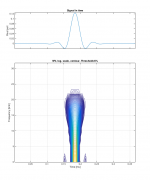Yeah but like you said, the filters don't do EQ. Something else is causing weak bass, can someone do an output impedance/ frequency plot on unbuffered output.
You obvious didn't read my post.
Have at least 5 dacs laying around. The dam has not weak bass in my setup. Initially I felt so. After playing some hundred hours this is not a problem. The bass is deep, powerfull and articulate.
With the latest "NOS" filters there is even more. ? Hard to describe.
Using unbuffered outputs.
AC 7.5V (50va trannie) direct into the dam.
Amplifer used for the time being has approx 10k input impedance
not so much amount more speed in transients
which filter do you find to be best in this department?
ill try it
Have at least 5 dacs laying around. The dam has not weak bass in my setup. Initially I felt so. After playing some hundred hours this is not a problem. The bass is deep, powerfull and articulate.
With the latest "NOS" filters there is even more. ? Hard to describe.
I'm struggling to decide whether this is an issue or not. In my system the bass is present, tight, and about as deep as is possible with bookshelf speaks that have response to 45Hz.
Comparing against my Konnekt 8 the DAM has less body in the bottom end BUT the Konnekt 8 is far darker overall, and has much less detail in the mid-range and highs. Music sounds as though it emerges from a dark curtain.
The DAM on the other hand is like looking into a sound recording, with empty space around each sound source, and the sounds positioned firmly. Bass is very tight, detailed and extended when it is there on the recording. Compared with the Konnekt 8, which is dark overall, the bass sounds a bit thin. The other side of that is the DAM's bass is detailed rather than a slightly amorphous blob.
I haven't listen to zfe's NOS filters, so can't comment directly, but a lot of what is going on is to do with perception of frequency response. There are at least two things happening simultaneously as far as I can tell.
Altering the transition band and/or window has a greater or lesser effect on the roll off in the audio band. Some of the filters are 2-3dB down at 20kHz and can be 0.5dB down at 16 or 17 kHz. The C128_100 is down by 0.05dB at 14kHz, 0.1dB at 15kHz for example.
This seems to change the tonal balance of the DAC to make the bass and lower mids more prominent rather than just making it sound rolled off.
You can see this occurring in the wv plots. The main part of impulse below 5kHz essentially doesn't vary.
The second thing that appears to be happening is that as the frequency increases the amplitude of the impulse decreases but it's spread in time increases, so the energy from the impulse smears in time.
What I'm finding is if you use aggressive windowing like the Chebyshev with 180dB side lobe suppression (see attached for C128_180) is that the HF time spread is reduced, but the amplitude remains roughly the same, meaning there is less overall energy in the mids and highs, which tends to make the bottom end sound a bit more weighty.
The main sidelobes seem to have an influence at low frequencies, and these may well contribute to perception of "better" bass by spreading the energy in time.
So I'm a bit torn. The things that look like they might contribute to "better" bass are precisely the things we are trying to avoid - steep roll-off and lots of pre-post ringing. On the other hand the things we think we like - slow roll-off and little pre/post-ringing by definition will reduce the amount of smearing, and side lobes, meaning the impulse is cleaner, and the sound more tightly focused.
Attachments
The DAM on the other hand is like looking into a sound recording, with empty space around each sound source, and the sounds positioned firmly. Bass is very tight, detailed and extended when it is there on the recording. Compared with the Konnekt 8, which is dark overall, the bass sounds a bit thin. The other side of that is the DAM's bass is detailed rather than a slightly amorphous blob.
Perfect description which is exactly what I sense with my DAM in two different systems (both headphone rigs... details were in some earlier post). Compared to my other DAC (fully tweaked Subbu with JG Buffer) the DAM probably has less volume but a good deal more definition/detail. DAM easily sounds better than the Subbu not only bass-wise.
So I'm a bit torn. The things that look like they might contribute to "better" bass are precisely the things we are trying to avoid - steep roll-off and lots of pre-post ringing. On the other hand the things we think we like - slow roll-off and little pre/post-ringing by definition will reduce the amount of smearing, and side lobes, meaning the impulse is cleaner, and the sound more tightly focused.
Hi Paul,
Do not confuse "more" bass with "better" bass.
I prefer a tight and detailed bass to a more present but blurry bass.
It's better to go for the best transparency for the whole frequency range,
and if there's not enough bass alter the frequency response of your speakers, I can play with 3 steps of 0.5db attenuation on the tweeter
or the FR of another component (God forbid : a tone control
Also your bookshelf speakers don't go that deep, some recordings have most of their bass very low.
Thanks for the great filter research!
Regards,
Danny
I don't really see an issue with the bass, its certainly present and very well defined on my HD800 cans as well as my cheap KEF tower floor speakers. Its about what I expect for a system that has a flat frequency response.
The raw unbuffered output goes into my Little Dot MK9 dual 6080 OCL/OTL headphone amp with the preamp outputs from that going into my loudspeaker tube amp. I believe its more to do with the impedance coupling on the unbuffered output than anything else.
The raw unbuffered output goes into my Little Dot MK9 dual 6080 OCL/OTL headphone amp with the preamp outputs from that going into my loudspeaker tube amp. I believe its more to do with the impedance coupling on the unbuffered output than anything else.
I only had the opportunity to listen to the first C128 and the C128_100 filter with my speakers, and had not the impression of that there was a bass issue.
But I encountered that bass issue several times in the past when I improved my equipment (not always DAC related). An a bit exaggerated description would be: before parts of music that were only "loud noise", afterwards show details and are precisely located in space, but the punch of bass that was there before is gone.
But by hazard, when moving around in the room, I noticed that at the right location (in the room) you still "feel some of the punch", but that location is different for different records.
I think it could be that the energy is now more precisely focused in space, whereas before you had it more or less everywhere.
But I encountered that bass issue several times in the past when I improved my equipment (not always DAC related). An a bit exaggerated description would be: before parts of music that were only "loud noise", afterwards show details and are precisely located in space, but the punch of bass that was there before is gone.
But by hazard, when moving around in the room, I noticed that at the right location (in the room) you still "feel some of the punch", but that location is different for different records.
I think it could be that the energy is now more precisely focused in space, whereas before you had it more or less everywhere.
I have the C128-100 right now.
I had the original impression that the bass is a bit weak on Dam, but directly comparing to BMC Puredac showed that the Puredac does the same fluffy bass almost in every situation, while Dam has proper resolution. The other thing is that Dam showcases compression much more easily, great tracks explode while weak compressed recordings are lifeless and dull.
Sometimes i feel like the bass might be a bit soft, kind of like dropping wet cloth, maybe it should hit with sharper edge. Apparent with some drum kits. But this could be just my imagination.
I had the original impression that the bass is a bit weak on Dam, but directly comparing to BMC Puredac showed that the Puredac does the same fluffy bass almost in every situation, while Dam has proper resolution. The other thing is that Dam showcases compression much more easily, great tracks explode while weak compressed recordings are lifeless and dull.
Sometimes i feel like the bass might be a bit soft, kind of like dropping wet cloth, maybe it should hit with sharper edge. Apparent with some drum kits. But this could be just my imagination.
Hi Paul,
Do not confuse "more" bass with "better" bass.
I prefer a tight and detailed bass to a more present but blurry bass.
I try not to confuse the two
The other thing I should mention is that jitter reduction makes a difference to the bottom end in my experience. I haven't done a switch for a while but on my D1v3 the difference between CS8412 recovered clocking and clocked from a digital PLL controlled Tent Labs VCXO was most noticeable as a significant improvement tightness and definition of the bass. It sounds comparatively thin in the bottom end but it's actually focus instead of flab.
I listened to slow sine sweeps for about ten minutes yesterday, and I couldn't detect any obvious variation in levels between 45-1000Hz.
As a bit of context the speakers I'm using are Audiovector Mi1 Signatures. They are an oldish model from 2004. I got them last year as a ex-demo item from the company that had until recently been the local distributor. Haven't been able to find much in the anglophone press about them. Hifi News awarded the Mi1 Sigs "editors choice" in 2004 but can't locate the review that is based on.
If you can manage to make any sense of the mashed googletranlatelish there was a review in High Fidelity (poland). There is an award summary in english which says
Audiovector is accompany true to its ideals for years, the most important is being true to the signal coming from the amplifier. Mi 1 Signature are the best example of that, because they play with incredibly clean, "transparent" sound with a very good treble.
https://translate.google.com.au/tra....pl/artykuly/0605/audiovector.html&edit-text=
The system I listen on is DAM (buffered XLR, direct trafo powering) -> Hypex UcD180HG+HxRs -> Audiovector Mi1 Sigs, so very strongly biased towards clean, detailed and accurate rather than "sugar-coated".
DAM probably has less volume but a good deal more definition/detail. DAM easily sounds better than the Subbu not only bass-wise.
I don't really see an issue with the bass, its certainly present and very well defined on my HD800 cans as well as my cheap KEF tower floor speakers. Its about what I expect for a system that has a flat frequency response.
But by hazard, when moving around in the room, I noticed that at the right location (in the room) you still "feel some of the punch", but that location is different for different records.
I think it could be that the energy is now more precisely focused in space, whereas before you had it more or less everywhere.
The other thing is that Dam showcases compression much more easily, great tracks explode while weak compressed recordings are lifeless and dull.
Sometimes i feel like the bass might be a bit soft, kind of like dropping wet cloth, maybe it should hit with sharper edge. Apparent with some drum kits. But this could be just my imagination.
Thanks for the comments. I broadly agree with what is said.
Like zfe I've noticed that bass strength is very position dependent - probably due to room modes etc. However there are phase differences between the filters so that could be a contributing factor. The phase is linear in that it is constrained between -180° to +180° but phase changes within that range are non-identical. I've seen discussion of zero-phase filters which might be an interesting avenue to explore, but I don't think I can do zero-phase with the Nyquist filters.
Classic Brickwall Filter
This is just a really straight up brick wall filter - I thought it might be worth having as a reference point.
It's flat to 20kHz, and is fully attenuated at 22.05kHz, with 95dB passband attenuation. The filter is done with a standard algorithm, and uses a hamming window. Nothing special, and nothing has been done to optimise the length which is 1015 taps.
This is just a really straight up brick wall filter - I thought it might be worth having as a reference point.
It's flat to 20kHz, and is fully attenuated at 22.05kHz, with 95dB passband attenuation. The filter is done with a standard algorithm, and uses a hamming window. Nothing special, and nothing has been done to optimise the length which is 1015 taps.
Attachments
As a bit of context the speakers I'm using are Audiovector Mi1 Signatures.
Seems good speakers, someone reviewed them and found them a bit light in the bass.
Just add some 10" woofers and you'll have your bass
While experimenting with frequency response plots (with octave) I noticed two things:
1. For plots of details the standard setting (length of the DFT) is too short.
2. The effect of the reduced resolution of the coefficients is only visible in the stopband attenuation.
As Illustration. I use the stock FIR1 and FIR2 filter, the plots are for the combined filter (FIR1, upsample, FIR2).
First plot the frequency response up to the Nyqvist frequency. Green the full double resolution of the coefficients, red reduced to 30 bits.
You see my second point.
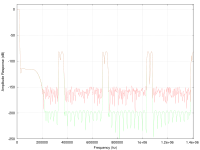
Next plot detail of the passband 20-18000Hz, obviously we have a problem with the frequency-wise resolution.
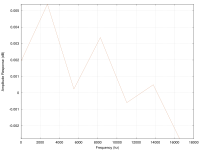
Next plots with DFT length 2^18
For the full frequency range we get not much more information, only more oscillation in the stopband.
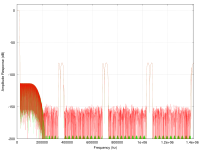
The detail plot of the passband now looks nice.
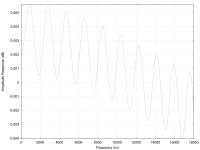
Here the (surely not optimal) code I used to produce the plots:
1. For plots of details the standard setting (length of the DFT) is too short.
2. The effect of the reduced resolution of the coefficients is only visible in the stopband attenuation.
As Illustration. I use the stock FIR1 and FIR2 filter, the plots are for the combined filter (FIR1, upsample, FIR2).
First plot the frequency response up to the Nyqvist frequency. Green the full double resolution of the coefficients, red reduced to 30 bits.
You see my second point.

Next plot detail of the passband 20-18000Hz, obviously we have a problem with the frequency-wise resolution.

Next plots with DFT length 2^18
For the full frequency range we get not much more information, only more oscillation in the stopband.

The detail plot of the passband now looks nice.

Here the (surely not optimal) code I used to produce the plots:
Code:
pkg load signal;
global fs=64*44100;
fir1= dlmread("/path/fir1.txt");
fir2= dlmread("/path/fir2.txt");
fir = conv(upsample (fir1, 8), fir2, "full");
function red = res(x)
% reduce resolution of x to aproximately 30 bits
red= round(x*2^(30))/2.0^(30);
end;
function [fr,db] = fdb(Hi,fi)
% transform x-y-axis
global fs;
fr= (fi/(2*pi))*fs;
db= 20*log10(abs(Hi));
end;
function [lr,ur,mi,ma] = pli(l,u, Hl,Hrl)
% min/max value for the detail plot
global fs;
lr=l;
ur=u;
a=max(1, idivide(2*l*length(Hl),fs));
b=idivide(2*u*length(Hl),fs)+1;
mi1=min(20*log10(abs(Hl(a:b))));
ma1=max(20*log10(abs(Hl(a:b))));
mi2=min(20*log10(abs(Hrl(a:b))));
ma2=max(20*log10(abs(Hrl(a:b))));
mi=min([mi1,mi2]);
ma=max([ma1,ma2]);
end;
[H,f] = freqz (fir);
fir_r=arrayfun(@res,fir); % reduced resolution to 30 bits
[Hr,f] = freqz (fir_r);
[a,b]=fdb(H,f);
[c,d]=fdb(Hr,f);
plot(a,b,'g',c,d,'r');
xlabel('Frequency (hz)');
ylabel('Amplitude Response (dB)');
axis([0.1, fs/2, -250, 10]);
grid('on');
print -FHelvetica -r300 -dpng fir_response1.png;
[lr,ur,mi,ma] = pli(20,18000, H,Hr);
axis([lr,ur,mi,ma] );
grid('on');
print -FHelvetica -r300 -dpng fir_response1det.png;
% long DFT
[H,f] = freqz (fir,1,2^(18));
[Hr,f] = freqz (fir_r,1,2^(18));
[a,b]=fdb(H,f);
[c,d]=fdb(Hr,f);
plot(a,b,'g',c,d,'r');
xlabel('Frequency (hz)');
ylabel('Amplitude Response (dB)');
axis([0.1, fs/2, -200, 10]);
grid('on');
print -FHelvetica -r300 -dpng fir_response2.png;
[lr,ur,mi,ma] = pli(20,18000, H,Hr);
axis([lr,ur,mi,ma] );
grid('on');
print -FHelvetica -r300 -dpng fir_response2det.png;
Last edited:
The phase is linear in that it is constrained between -180° to +180° but phase changes within that range are non-identical. I've seen discussion of zero-phase filters which might be an interesting avenue to explore
I thought linear phase is just zero phase plus latency/delay in time ...?
Seems good speakers, someone reviewed them and found them a bit light in the bass.
Just add some 10" woofers and you'll have your bass
I have a sneaking suspicion that adding 10" woofers won't do much to alter the comparative differences in tonal balance of DAC's compared side by side using the same amp and speaker.

DAC now all boxed up so time this evening to have a good listen to everything from 44-384k files, some original cd rips, some dsk, some up-sampled, all through usb input. Now favouring the newNOS for power, dynamics, transparency and soundstaging, and ability to lift out the smallest detail in the music - try Chesky's Ultimate Demo disk if you can. NOS may not measure as well as others with the scope, but with my ears.... Have fixed the Tag processor so can listen to CDs tomorrow through all Tag and compare with the new DAC, probably via Big Ben clock, which I know works very well.
- Home
- Source & Line
- Digital Line Level
- Filter brewing for the Soekris R2R
